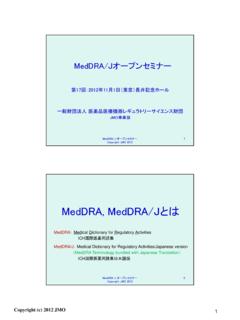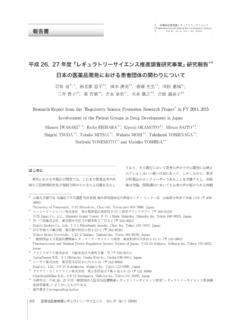Transcription of European Pharmacopoeia - PMRJ
1 European Pharmacopoeia Edition 2012/2013 Looking for impurity reference standards with CofAs? See our impurity chapter from page 11 on. 249 European Pharmacopoeia Background The European Pharmacopoeia (EP) Commission includes in its membership delegates from nations who have adopted the European Pharmacopoeia . The EP Commission is in charge of judging the suitability of monographs. Prior to release, a new monograph must be adopted by the EP Commission, and then published in the annual Fascicule . Member States then officially adopt the new monograph on 1st January of the following year.
2 To support the monographs of the European Pharmacopoeia , a collection of reference substances has been made available which includes: 1. Current, official, European Pharmacopoeia Chemical Reference Substances (EP CRS) and Biological Reference Preparations (BRP) 2. Reference Spectra 3. Other reference preparations, including Enzymes and Substrates from the International Commission on Pharmaceutical Enzymes and Certified Viscosity Standards from Van Swinden Laboratories. 4. With supplement , the revised EP general method replaces CRS reference liquids with certified reference materials available from suppliers of chemical reagents or materials certified for metrology.
3 Ten liquid CRMs, certified by the Physical Chemistry Division of the Central Office of Measures (GUM), Warsaw in Poland, cover the wide range of refractive index from 1,333 (water) to 1,657 (1-bromonaphthalene). More detailed information is given in the chapter "Dyes and refractive index CRMs" of this catalogue. 5. European Pharmacopoeia Reagents. Relationship with other pharmacopoeias in Europe Any reference substance, spectra or preparation required for a new EP monograph, is made available as soon as the monograph comes into force. Many of the member countries of the European Pharmacopoeia Commission have adopted the EP in full, and their monographs require only EP CRS/BRP.
4 When an EP monograph is adopted by the Pharmacopoeia of a member state of the Council of Europe then any reference material that may have been available from a national Pharmacopoeia , BP or PF, will usually be discontinued in favour of the EP reference substance. However, a number of member countries of the EP Commission maintain national pharmacopoeial monographs, especially for finished dosage forms, which require the use of separate reference substances. A separate chapter in this catalogue includes lists of the reference substances produced for the British, French, Swiss and International Pharmacopoeia monographs.
5 The International Pharmacopoeia (IP) reference substances are described in the section referring to the WHO (World Health Organization). Production and certification European Pharmacopoeia reference substances and preparations are selected and verified by the EP laboratories as being suitable for the use as prescribed in the relevant monograph of the European Pharmacopoeia . Since CRS and BRP are officially certified by the European Pharmacopoeia Commission, it should be noted that neither certificates of analysis nor data not relevant to the use of the products as defined by the EP monograph are provided with the reference product or substance.
6 European Pharmacopoeia 250 Looking for impurity reference standards with CofAs? See our impurity chapter from page 11 on. Edition 2012/2013 Storage, shelf life and expiry dates and size units European Pharmacopoeia CRS/BRP are subject to regular inspection and repeated analysis by EP scientific staff. Each EP CRS/BRP is, on receipt by the customer, fit for the intended use. No expiry date is indicated on the reference materials because the products or substances comply with the requirements of the corresponding monograph and are monitored regularly.
7 When batches are to be changed, LGC Standards can provide you with the date on which the previous lot will no longer be official. In specific cases for reasons related to filling or labeling, sub-batches are obtained from the same batch of bulk material. However, all the necessary precautions are taken in order to guarantee that the quality and specifications of the sub-batches do not differ from one to another. Please note, that new lots can have different unit sizes, especially with pharmacopoeial reference standards, and LGC Standards is not responsible for such cases.
8 If the unit size of a new batch changes, LGC Standards will provide this information to customers in new lot lists. The EP is also currently over-labelling all its reference standards vials with a secondary label. This new secondary label is useful for customs purposes as it can be peeled off. It can also be stuck onto your laboratory book to prove the use of the reference standard. All the required information to perform the tests described in the European Pharmacopoeia monographs are stated on the primary label. EP recommends only sufficient material should be purchased for immediate use and that unopened vials should be stored in the dark unless otherwise stated.
9 Whilst most EP CRS/BRP can be shipped at ambient temperature, certain items have to be maintained at controlled temperatures at all times and are subject to special shipping charges and storage conditions (details are available on request). Where no drying conditions are stated, the substance is to be used as received. Once opened, EP can no longer guarantee the stability of the material and any of the CRS/BRP not used should be disposed of and not kept for future use. Validation of secondary standards All secondary in-house working standards have to be validated against the corresponding EP CRS/BRP.
10 Please make sure that the secondary material is used only for the same official purposes for which the primary pharmacopoeial material was designed. Proper use EP discontinued their use code number system as of January 2006. For information on the use of the substances please refer to the monograph or contact your local LGC Standards office. Opening For reference substances and preparations supplied in sealed glass ampoules the following technique is suitable for opening the ampoule: tap gently to collect the material at the lower end, score the ampoule with a file, heat a glass rod to white heat and apply firmly to the file mark.





![01 OS MedDRAとは201103(final).ppt [互換モード]](/cache/preview/3/8/e/4/b/f/5/7/thumb-38e4bf578f48897d27e0ad38eaa72b92.jpg)
